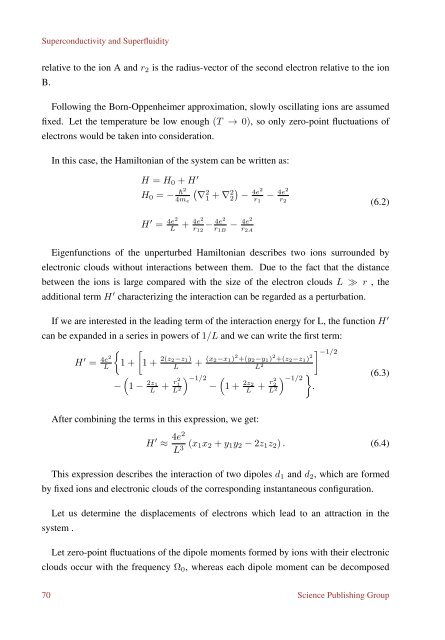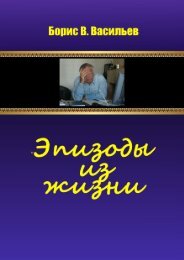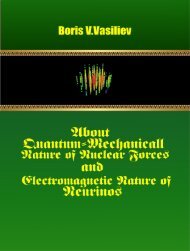978-1-940366-36-4_WholeBook
Boris V. Vasiliev Supercondustivity Superfluidity
Boris V. Vasiliev
Supercondustivity Superfluidity
You also want an ePaper? Increase the reach of your titles
YUMPU automatically turns print PDFs into web optimized ePapers that Google loves.
Superconductivity and Superfluidity<br />
relative to the ion A and r 2 is the radius-vector of the second electron relative to the ion<br />
B.<br />
Following the Born-Oppenheimer approximation, slowly oscillating ions are assumed<br />
fixed. Let the temperature be low enough (T → 0), so only zero-point fluctuations of<br />
electrons would be taken into consideration.<br />
In this case, the Hamiltonian of the system can be written as:<br />
H = H 0 + H ′<br />
( )<br />
H 0 = − 2<br />
4m e<br />
∇<br />
2<br />
1 + ∇ 2 2 −<br />
4e 2<br />
H ′ = 4e2<br />
L<br />
+ 4e2<br />
r 12<br />
− 4e2<br />
r 1B<br />
− 4e2<br />
r 1<br />
− 4e2<br />
r 2<br />
(6.2)<br />
r 2A<br />
Eigenfunctions of the unperturbed Hamiltonian describes two ions surrounded by<br />
electronic clouds without interactions between them. Due to the fact that the distance<br />
between the ions is large compared with the size of the electron clouds L ≫ r , the<br />
additional term H ′ characterizing the interaction can be regarded as a perturbation.<br />
If we are interested in the leading term of the interaction energy for L, the function H ′<br />
can be expanded in a series in powers of 1/L and we can write the first term:<br />
{ [<br />
] −1/2<br />
H ′ = 4e2<br />
L<br />
1 + 1 + 2(z2−z1)<br />
L<br />
+ (x2−x1)2 +(y 2−y 1) 2 +(z 2−z 1) 2<br />
L 2<br />
(<br />
) −1/2 (<br />
) −1/2<br />
− 1 − 2z1<br />
L + r2 1<br />
L − 1 + 2z2<br />
2 L + r2 2<br />
L<br />
}.<br />
2<br />
(6.3)<br />
After combining the terms in this expression, we get:<br />
H ′ ≈ 4e2<br />
L 3 (x 1x 2 + y 1 y 2 − 2z 1 z 2 ) . (6.4)<br />
This expression describes the interaction of two dipoles d 1 and d 2 , which are formed<br />
by fixed ions and electronic clouds of the corresponding instantaneous configuration.<br />
Let us determine the displacements of electrons which lead to an attraction in the<br />
system .<br />
Let zero-point fluctuations of the dipole moments formed by ions with their electronic<br />
clouds occur with the frequency Ω 0 , whereas each dipole moment can be decomposed<br />
70 Science Publishing Group













